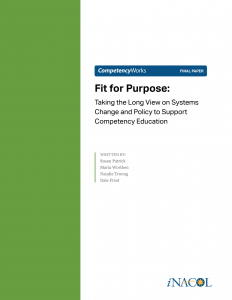Sketching Out the Vision for a Competency-Based Policy Platform
CompetencyWorks Blog
 It’s hard, really hard, to imagine different worlds. Sure, science fiction writers and film directors must have a blast creating new worlds that inspire us, frighten us, or both. Being able to imagine a world where the education system consistently produces engaged, motivated students who are excited about their futures and graduating with a basket of knowledge and tools that open up doors to the world they want to live in requires a mix of creativity and analysis. Harder yet is imagining what the policy would need to be for this world that we are just beginning to build district by district, school by school.
It’s hard, really hard, to imagine different worlds. Sure, science fiction writers and film directors must have a blast creating new worlds that inspire us, frighten us, or both. Being able to imagine a world where the education system consistently produces engaged, motivated students who are excited about their futures and graduating with a basket of knowledge and tools that open up doors to the world they want to live in requires a mix of creativity and analysis. Harder yet is imagining what the policy would need to be for this world that we are just beginning to build district by district, school by school.
The team of people involved with shaping the ideas and writing the paper Fit for Purpose: Taking the Long View on Systems Change and Policy to Support Competency Education are doing just that. They are sketching out for all of us what the policies are going to need to look like and what they are going to need to do in order to support personalized, competency-based systems.
If you remember, iNACOL/CompetencyWorks used a participatory process, referred to as the Technical Advisory Group, to develop draft papers before the National Summit on K-12 Competency-Based Education. At the Summit, we collected feedback from the participants in order to fine-tune the ideas. Today, the final version Fit for Purpose: Taking the Long View on Systems Change and Policy to Support Competency Education is being released.
There is a lot in the paper to chew on. Personally, I find the concept of threshold concepts really helpful. They are “core concepts, that once understood, are needed to transform a given subject.” In other words, they require time to learn about, a process to analyze not only what it means for the future but what it means for how the traditional system operates, and a set of colleagues to engage in a dialogue about the implications and what it can mean for each of our own work.
The paper outlines four threshold concepts:
- Certifying learning;
- Assessment literacy;
- Pedagogical innovations based on learning sciences; and
- Meeting students where they are.
I’ve spent a lot of time on the last one and a final version of that paper is forthcoming. Certainly, with CZI investments, we are all going to be talking about and learning about the learning sciences. Thus, I find myself spending much more time thinking about what it means to certify learning. What would it mean for a district to tell a student and a parent that they have fully demonstrated mastery of level seven regardless of the age of the student? What would it take for us to have consistency across the inner city, inner suburbs, and outer suburbs in what it means to master level seven math?
In terms of assessment literacy, there are some huge shifts going on in how we think about assessment. For example, it’s much more powerful to think about it as a process than an event. Assessment doesn’t have to be something a teacher does to or for a student. If what it means to demonstrate mastery is transparent, students can be pulling together examples of their work to demonstrate that they have really learned the knowledge and skills.
Of course, talking about a future system or a new set of policies is much easier than actually building that new school, changing the system, or building the public will for a new policy. We need to make sure that we stay informed by what educators at the school, district, and state levels are learning so that we create meaningful, sustainable policies that make it easier for them to help our students learn.
See also: